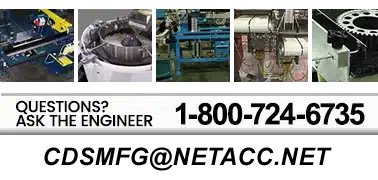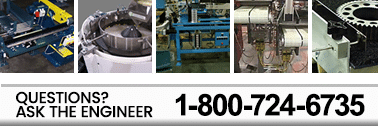CDS-LIPE’s sorting machines are designed for seamless integration with existing production lines through careful engineering of their interfaces and control systems.
Here is a breakdown of how they achieve this integration:
Physical and Mechanical Integration
- Custom Infeed and Outfeed Systems: The core of integration lies in matching the sorting machine’s inputs and outputs to your existing line. CDS-LIPE designs custom infeed conveyors, linear vibratory feeders, or chutes that precisely accept parts from the upstream machine (e.g., a press, a mold, or a furnace). Similarly, the machine is built with multiple outfeed channels (pass, fail, re-inspection) that align perfectly with downstream assembly tracks, packaging lines, or reject bins.
- Adjustable Height and Footprint: Sorting machine frames are often engineered with adjustable height components and a compact footprint to fit within existing floor plans and match the elevation of neighboring machinery without requiring major structural modifications to the facility.
- Part Handling Alignment: For high-speed systems, the machine must ensure the part is stable during inspection. The integration often involves custom fixturing, nests, or alignment mechanisms to transition the part smoothly from the existing transport system onto the sorting machine’s inspection track.
Electrical and Control System Integration
- PLC Compatibility: CDS-LIPE machines use industry-standard Programmable Logic Controllers (PLCs) (e.g., Allen-Bradley, Siemens). This allows the sorting machine’s control system to easily communicate with your existing master production line PLC.
- I/O Communication: The machines utilize standard Input/Output (I/O) signals to communicate status:
- Upstream: The sorter can signal the upstream machine to stop feeding if its buffer is full or if a major defect trend is detected.
- Downstream: The sorter provides a Ready/Not Ready signal to the downstream system, ensuring components are only fed when the next process is available.
- Data Exchange (Industry 4.0): Modern CDS-LIPE sorters are capable of sophisticated data integration using protocols like EtherNet/IP or OPC UA. This allows Process Engineers to pull real-time quality data (e.g., defect rates, measured dimensions, throughput) directly into the plant’s Manufacturing Execution System (MES) or Supervisory Control and Data Acquisition (SCADA) systems for historical logging and analysis.
- HMI Integration: The Human-Machine Interface (HMI) is designed to be intuitive and can often be configured to display status relevant to the entire cell, not just the sorter, aiding operator workflow.
By focusing on these custom physical and digital interfaces, CDS-LIPE ensures its sorting machines function not as standalone units, but as an invisible, high-precision checkpoint within your existing automated line.
Integrating advanced sorting machines into existing manufacturing lines presents several common challenges that process engineers must address. These fall mainly into three categories: Mechanical, Control System, and Operational.
Mechanical and Physical Integration Challenges
The primary goal is to ensure smooth, non-disruptive part flow from the existing equipment into the sorter and out to the next station.
- Part Handover and Stability: The most critical challenge is the transfer point. The upstream conveyor, feeder, or robot must present the part to the sorting machine’s inspection track in a precise, repeatable manner without damaging the part or compromising its orientation. For high-speed lines, even minute misalignment can cause jams.
- Space and Footprint Constraints: Existing factories often have tight spaces. Integrating a new, large piece of equipment requires creative engineering to fit the sorter without blocking access for maintenance or violating safety clearances.
- Vibration Isolation: If the sorting machine uses vibratory technology (or is next to existing vibratory feeders), ensuring that the vibrations do not interfere with the extremely sensitive optical or laser inspection systems is vital. Poor isolation can lead to inaccurate measurements and false rejects.
- Reject Mechanism Reliability: Designing a reliable and high-speed reject mechanism that cleanly removes failed parts without disturbing the stream of accepted parts is technically demanding. The reject chute must also prevent rejected parts from bouncing back into the line.
Control System and Data Integration Challenges
The sorting machine needs to “talk” to the rest of the factory’s automated equipment.
- Communication Protocol Mismatch: Older lines may use outdated or proprietary communication protocols (e.g., DeviceNet) while new sorters use modern standards (e.g., EtherNet/IP, Profinet, or OPC UA). Bridging this communication gap often requires intermediate hardware (gateways) or complex PLC programming.
- Timing and Synchronization: The sorter’s PLC must be perfectly synchronized with the speed and cycle time of the upstream and downstream machines. Miscommunication of simple signals (like “Start,” “Stop,” or “Buffer Full”) can lead to cascading stoppages.
- Data Integration and Reporting: Extracting the valuable quality data (e.g., individual measurement results, defect statistics, process trends) from the sorter’s internal database and integrating it into the plant’s MES (Manufacturing Execution System) or ERP system for historical tracking is often complex and requires custom software interfaces.
Operational and Process Challenges
These challenges impact the long-term performance and maintainability of the integrated system.
- Recipe Management: If the production line runs multiple product SKUs, quickly changing the sorter’s inspection “recipe” (e.g., new dimensional tolerances, a different lighting setting) simultaneously with the changeover of the other line machines is difficult but necessary to minimize downtime.
- Cleanliness and Maintenance Access: Especially in medical or food processing, the sorter must be designed for easy cleaning access to meet sanitation standards. Integration must not complicate the CIP (Clean-In-Place) or washdown procedures of the surrounding equipment.
- False Reject Optimization: Initially, the biggest operational challenge is tuning the sensors and software to minimize false rejects (good parts flagged as bad) while maintaining zero false acceptances (bad parts passed as good). This requires iterative testing and collaboration between the vendor (like CDS-LIPE) and the client’s process engineers.





